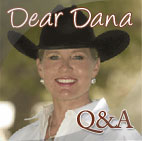More with Les Bio
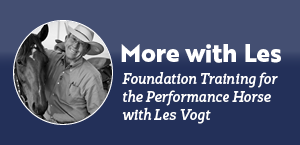
More about Les Vogt
Les Vogt has won more than 15 World Championships, including two wins at the NRCHA Snaffle Bit Futurity. Today Les focuses is giving clinics around the world and developing products for the performance horseman. To learn more about Les and to see his clinic schedule, visit www.lesvogt.com.
Troubleshooting Tips
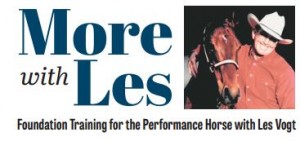 Losing forward motion
Losing forward motion
You always want to be riding the back end of the horse up to the front, but the most common mistake new riders make is to pull the horse back instead of pushing him around. This will cause the horse to interfere with his front legs, and then he won’t want to turn anymore. If the horse should start to shift his weight backward rather than moving freely around the turn, you will want to walk him out of the turn right away and then go try again somewhere else.
I’ve said it before, but an important thing to remember is that any time you feel like your horse would have to shift his weight in order to walk forward and out of the turn, it means he’s hanging back too far. You want to get him moving forward in a hurry before he starts to get comfortable there. If he’s hanging back, he’ll never be able to master the proper footwork or comfortably build up any speed. Set him up so he can move freely. If it starts to feel awkward, get out of it and start again.
Running Martingales: A good fit?
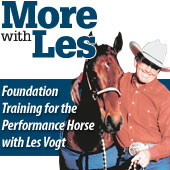 Fifth in a series
Fifth in a series
Les takes a look at why a martingale serves a purpose in early stages of training.
I will use a running martingale occasionally, and I recommend them for many riders. I like a heavy leather one, and I want it adjusted so that the rings of the martingale can go all the way to the horse’s throatlatch when he’s standing relaxed. That means his head, or your hands, would have to really get up there before the rings actually pulled on the reins. The martingale is not there to pull your horse’s head down; its main function is to add weight and balance to the reins during the learning process.
Troubleshooting turnarounds: Here’s a review
75th in a series
Last issue, Les showed us in detail what turnarounds should look like; here’s what to do if they don’t.
If the horse keeps trying to go forward once you’ve asked him to start the turnaround, just keep him in the proper bend and keep pushing his pivot foot up underneath him with your legs. He’ll eventually figure out that stepping into the turnaround is the easiest response to the cues that you’re giving him.
Alignment in circles: Posture a key
67th in a series
Last issue, Les took us into circles and the importance of shoulder control. Now we’ll look at alignment.
Next up: Circles and lope departures
66th in a series
After working on hip control and developing cues in the last two issues, Les moves us into circles and departures.
Some folks find the circles in a reining program to be the boring part, but you’ve got to face the fact that if you’re going to show, you’ll spend most of your time in the pattern circling, so why not make them look good? Especially when many patterns call for circles before the other maneuvers. You only get one first impression, and if the judges don’t like how your horse handles in the circles, they’re going to know right where to look for faults in the rest of your maneuvers.
Troubleshooting: What to look for
50th in a series
Last issue, Les finished up details of turnaround exercises. Now, we’ll look at what we’ve covered, and how to keep our efforts on track.
Running Martingales: A good fit?
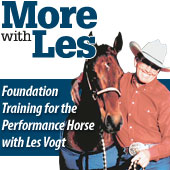 Fifth in a series
Fifth in a series
Les takes a look at why a martingale serves a purpose in early stages of training.
I will use a running martingale occasionally, and I recommend them for many riders.
I like a heavy leather one, and I want it adjusted so that the rings of the martingale can go all the way to the horse’s throat latch when he’s standing relaxed. That means his head, or your hands, would have to really get up there before the rings actually pulled on the reins. The martingale is not there to pull your horse’s head down; its main function is to add weight and balance to the reins during the learning process.
More with Les: The Five Easy Pieces
Exercises to move and take control of your horse’s different body zones
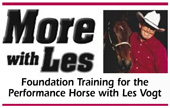 Continuing in a Series
Continuing in a Series
In the next few installments, Les Vogt takes you through exercises of his Five Easy Pieces. When you’ve mastered them, you should be able to put any part of your horse’s body where you want it, without resistance. This time, we continue discussing the second piece, Exercise No. 2: Shoulder Control.
More with Les: The Five Easy Pieces
Exercises to move and take control of your horse’s different body zones
 Continuing in a Series
Continuing in a Series
In the next few installments, Les Vogt takes you through exercises of his Five Easy Pieces. When you’ve mastered them, you should be able to put any part of your horse’s body where you want it, without resistance. This time, we introduce Exercise No. 2: Shoulder Control.
Up until this point, we’ve primarily focused on influencing the horse’s head and neck through lateral and vertical flexion. In this lesson, you’re going to move back a zone and learn to control the shoulders. Once you can do that, it opens the door for many of the maneuvers that you’ll be working on in the future.


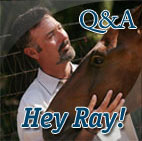
 Read Columns
Read Columns
